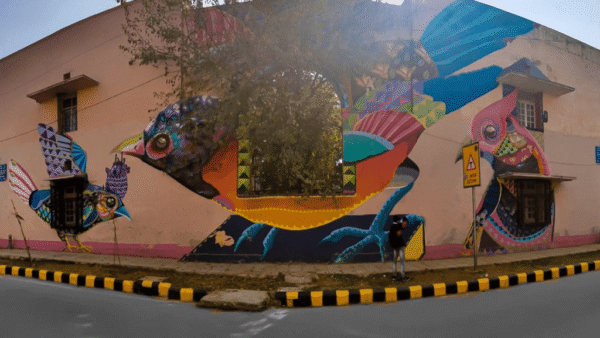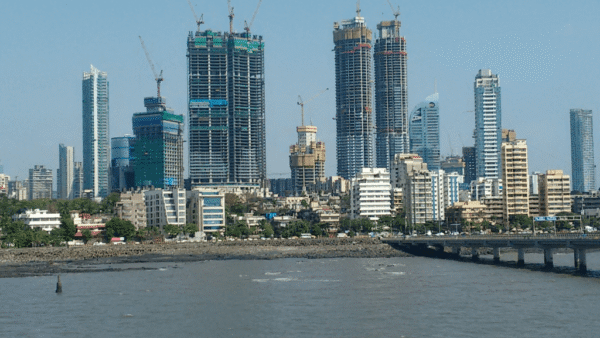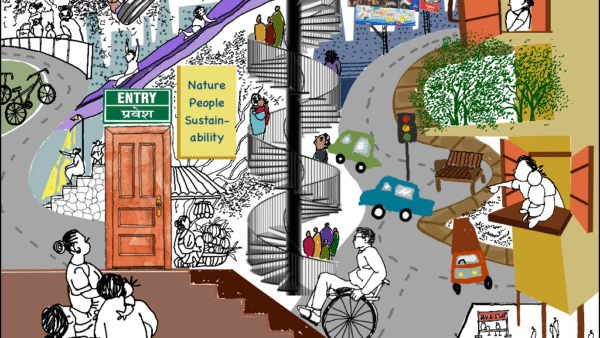At the edge of Bengaluru, where the city’s glittering skyline fades into informal peripheries, lies Laggere. A part of it is a vast resettlement colony shaped not by aspiration, but by eviction. Stacked between the Peenya Industrial Area and the Outer Ring Road of Bengaluru, the resettlement colony was constructed by the Karnataka Slum Development Board over many years, with phases of evictees from the city being rehabilitated here since the 1980s. Displacement from central parts of the city due to various construction and infrastructure projects has brought more than 4,000 families.
Spread over 49 acres, this neighbourhood is emblematic of what urban scholar Kaveri Haritas (2021) calls an “accumulation of dispossession.”[1] Composed of tightly packed crumbling apartment blocks, and narrow lanes, Laggere houses those pushed out of central slums to make way for the city’s ‘development’. These are what the officials term as project-affected people; the projects are for the city, the effect is on their lives.
In the dense, crisscrossing alleys of Laggere’s marginalised settlement, something remarkable unfolds each evening: life, laughter, and play. Our short film Playing in the Field, captures this unexpected vitality. It explores how children in Laggere reclaim their right to play and to leisure, unconscious that they are doing so, in an environment that was never designed to nurture play and leisure.
The resettlement colony, of course, does not have a public playground or any facility for children’s leisure. So, leisure must be invented from leftovers. How has this been done? The children of Laggere, and the adults too, have found their own ways of claiming what was not provided to them during their “planned” rehabilitation. Watch our short film below.
Meet the ‘players’
Playing in the Field illuminates three intimate portraits of everyday innovation in Laggere’s resettlement colony. Through the lens of play, we trace the motivations, aspirations, and quiet ingenuity of three individuals — Syed Amir, Salma, and Razzak who animate the colony’s social and material life. The film delves into the places and objects of leisure claimed by children amidst the lack of planned state infrastructure for play. In addition, it also looks at the processes by which these individuals have crafted their small businesses, artefacts, and places of leisure – a local economy of care and comfort. The film explores how people living in a low-income resettlement colony have enabled leisure for themselves in and outside the colony.
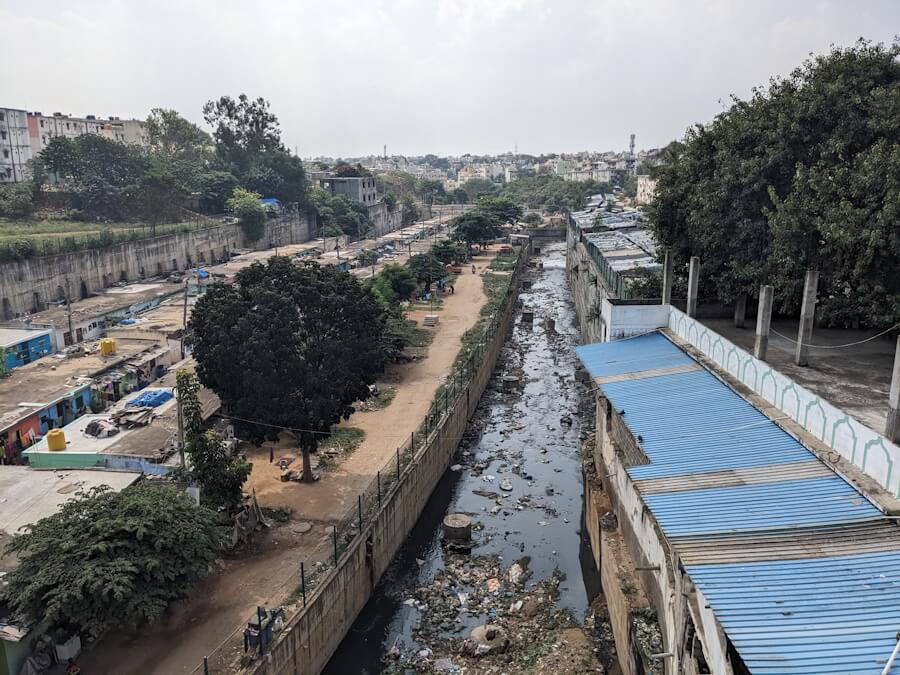
The film largely focuses on children’s play, the objects they use or craft with, and the places they occupy through these three stories. We first meet Syed Amir, a shopkeeper, who runs a toy shop in Laggere. He brings toys like kites–often made with scrap plastic, and tops (lattoos) for the kids from Chikpette, one of Bengaluru’s biggest markets, and sells them at a low price. From kites to golis to light toys, he talks about buying toys according to the season. “I only purchase toys that children prefer. Everything is priced between Rs 5 and Rs 10. I won’t buy toys that won’t be bought by them,” says Amir.
The second story is about Salma who has a small cycle renting business. Along with her husband, she refurbishes old cycles and cycle parts to assemble usable cycles for kids to rent and ride. Some of these are sold for between Rs 800 and Rs 1,500 to those who want to buy them. She has devised an efficient system in which she clicks a photo of every child with the cycle they rent to keep a record. She rents out about five cycles a day.
Finally, there is Razzak, a musician and instrument-maker who crafts sarangis from coconut shells, cassette reels, and other scrap materials—it is the only means of his livelihood. The long process involves sourcing materials from different places and it takes him eight days to make about 30-40 pieces of the instrument. Passed down from his family, his musical skill is now his livelihood, and his instrument is the string that connects the colony to the city’s fairs and public spaces
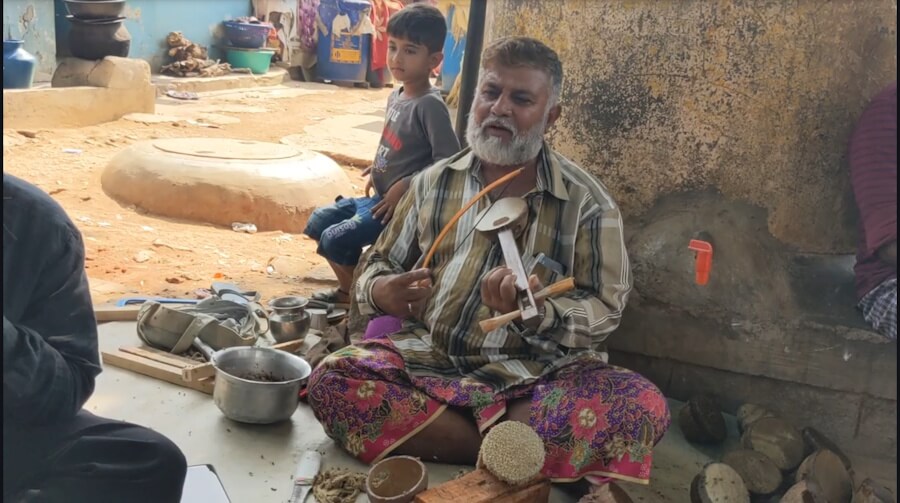
Places and objects of leisure in the resettlement colony
When the resettlement colony comes alive at dusk, its otherwise underserved narrow lanes turn into community playgrounds. The film immerses us in these evening rhythms of children bouncing chingis (a toy made by bunching rubber bands together), spinning lattoos using bottle caps grips, and kites with plastic scraps tailing them, slicing the sky.
Our film foregrounds the frugal creativity, resourcefulness and solidarities that define and enable leisure in Laggere’s resettlement colony. Play becomes both protest and possibility in a colony where formal planning has failed to account for children’s basic right of play. At its core, this is about how children make space for joy in an environment of scarcity.
The team chose Laggere as the focus of the film because it exemplifies the intersection of urban displacement and the resilience of marginalised communities. As one of Bengaluru’s largest resettlement colonies, Laggere has been home to over 16,000 families relocated due to infrastructure projects since the 1980s. By highlighting these everyday acts of ingenuity, our film underscores the importance of recognising play as a fundamental right and the need for inclusive urban planning that addresses the holistic needs of all residents.
Their efforts are a searing critique of how leisure and play are deprioritised in urban planning, especially in low-income settlements like Laggere where state provided housing stands oblivious to the holistic needs of children, where basic amenities like water and electricity are often retrofitted, and spaces for rest, play, or imagination are absent. The streets of the resettlement colony, so often viewed as symptoms of infrastructural failure by the rest of Bengaluru, are reimagined by its children as vital spaces of encounter. The absence of designated parks or playgrounds does not stifle their joy; rather, joy blooms in the nooks and crannies of the colony.
Our film challenges the silence around the issue and the voices that point only to the noise of playing children. It reminds us that the Article 31 of the UN Convention on the Rights of the Child[2] enshrines the right to play as fundamental to every child’s development. Yet, in Laggere’s resettlement colony, this right has been crafted from waste, negotiated through community bonds, and sometimes bought with borrowed coins.
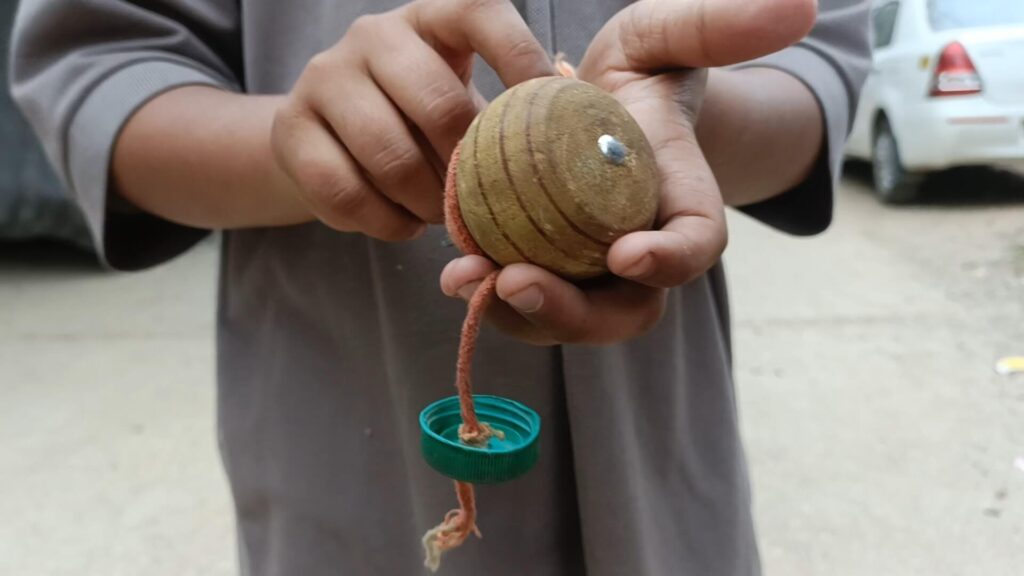
Enabling leisure in Laggere
The three stories invite us to pay attention to the subtle and active ways in which people reclaim their city and its spaces by, literally, playing in the field. In 2023, the year we filmed this, the residents had formally petitioned the local councillor to convert a waste dumping site into a playground – a request that, to this day, remains unanswered.
For us making the film, the stories here are a testament that low-income or low-priority communities yearning for spaces of leisure are often pushed to create them by their own grit and imagination. People do not wait. When these spaces are excluded from the official plan, they are made by the people themselves. When toys are unaffordable, they are invented. People’s creativity and resourcefulness remain resilient against the apathy of authorities.
Yet, we recognise that these stories are by no means a marker of sufficiency. They are not a substitute for the children’s right to play, nor can a community’s creativity absolve the state of its responsibilities to provide children’s basic rights in such ‘planned’ settlements. Cities must account for the emotional and developmental landscapes of childhood. Children’s play needs to become a necessary element in city plans so that cities are livable and compassionate.
Playing in the Field is not just a documentation of play here but of the assertion of rights. It tells us that even in places marked by scarcity, children will find ways to run, to build, to laugh. But it also insists that this inventiveness should not be mistaken for sufficiency or absolve the authorities. In doing so, our documentary nudges people to ask what it would mean to reimagine cities through a child’s lens. How would planning look if play were treated not as a luxury, but as a right, a right for all children from those living in the posh complexes to the inventive and energetic ones in places like Laggere?
This film was produced by the six urban fellows as a part of the Practica project of the Urban Fellows Program at the Indian Institute for Human Settlements(IIHS), Bengaluru. This project was carried out from August to December 2023. The team extends special thanks to Juwairia Mehkri, Namrata Kapoor, Divya Ravindranath, and Swarnika Sharma for their invaluable support and guidance throughout the process.
Photos: Team Manzil


